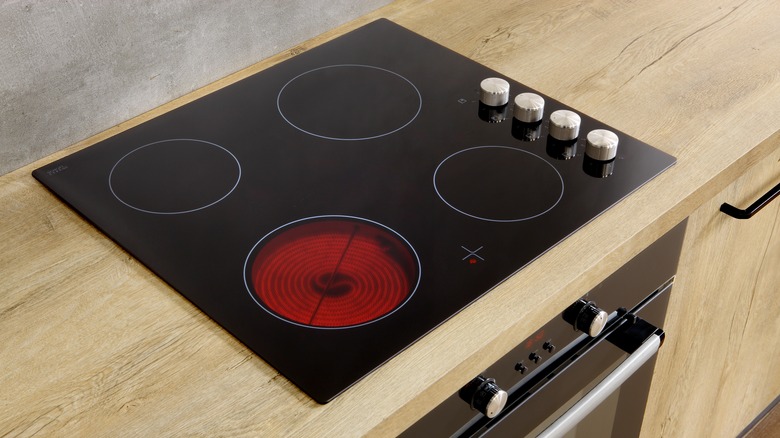
Electric stove top turned on
Thanks to their long association with professional kitchens, gas stoves have a reputation as being the best type of cooking appliance around. This has led many home cooks to purchase and use gas stoves, too. However, public opinion is shifting and electric stoves are becoming increasingly popular in the United States. In a survey of 18,500 homes, Statista found that 68% of households owned an electric stove. By comparison, only 38% of households owned a gas stove.
One of the driving reasons behind America’s shift to electric stoves is concerns over the polluting nature of gas stove tops. It has been stated that children are 42% more likely to develop asthma and are at a 24% increased risk of having asthma for their entire lifetime if they live in a home where gas is used for cooking. Of course, there are also environmental reasons for making the switch from gas to electric, the main one being that the latter can be produced using renewable energy resources while the former cannot.
Switching from a gas oven to an electric one is relatively straightforward. However, the move from using a gas stove top to an electric stove top is not so easy. In the following article, we have highlighted several mistakes people often make when cooking on electric stove tops as well as solutions to them using studies and reports from professional chefs. After all, changing to electric shouldn’t mean your cooking has to suffer.
Expecting Stove Top Temperatures To Change Rapidly

Changing temperature on stove top
Those who are used to cooking on gas take the ability to rapidly change temperatures for granted. Turn up the flame, and the heat instantly increases. Turn it down to a whisper, and the temperature plummets. Traditional electric stove tops do not react so quickly because it takes time for the heating element to either heat up or cool down. That being said, induction hobs — a type of electric-powered stove top — are deemed as, if not more responsive to temperature changes than gas.
Home cooks can still achieve rapid temperature changes when cooking on traditional electric stove tops by using different temperature-controlling practices. In terms of rapidly reducing the cooking temperature, the best method is to move the pot onto an adjacent burner, which is either turned to a lower setting or is off entirely. This two-burner method can also be used in reverse for high-temperature cooking techniques, such as searing. If two burners are not used, the electric stove top’s inability to rapidly heat or cool itself means the intended cooking practice will likely go awry.
Not Matching The Size Of The Burner With The Cookware
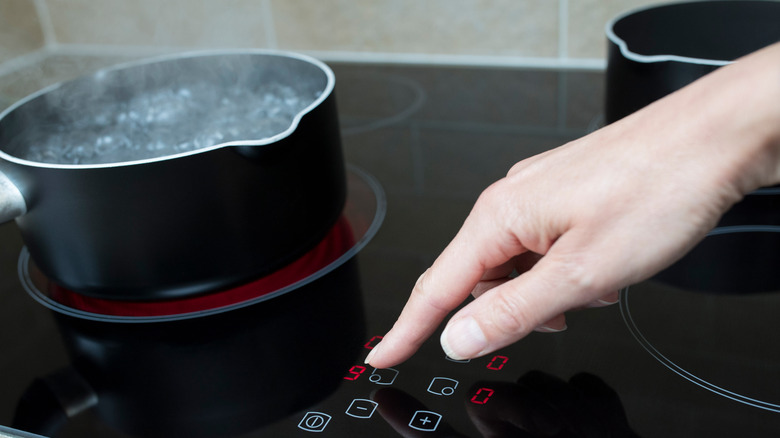
Pan being used on burner
The vast majority of electric stove tops boast four burners, each one a different size. To maximize the efficiency and effectiveness of cooking, those using electric stovetops should match the size of the burner with an equally sized pot, pan, or skillet.
In terms of energy efficiency, the savings made by correctly matching burners and cookware are staggering. It’s been reported that at least 40% of a burner’s energy is wasted if a 6-inch pan is used on an 8-inch burner, according to Smarter Home. The larger the size differential, the greater the energy waste will be. What’s more, some electric stove tops — especially induction hobs — will not put out the maximum power if they sense that a smaller pan is being used, affecting cooking temperatures and times.
Using a pot that is larger than the burner poses its own issues. This is for the simple reason that the temperature of the pot’s surface will vary; the portion sitting outside the burner will be considerably cooler than the portion on top of it. This will lead to food being unevenly cooked.
Confusing Induction And Electric Stove Tops

Person turning on induction hob
Both induction and electric stove tops are powered by electricity. However, the way they transfer heat and, subsequently, their characteristics are notably different. Instead of using a heating element, induction stove tops work by creating a magnetic field that causes the metal pot or skillet itself to heat up. This process means that induction hobs boast nearly 100% energy efficiency and are incredibly responsive to any temperature changes dictated by the cook.
Induction stove tops are being touted by many as the future for home kitchens, as J. Kenji López-Alt highlighted to Gear Patrol: “If I had the opportunity to build a home kitchen from scratch, I’d go with an induction range for sure. It’s safer, better for the environment, more easily controllable and for the majority of things I cook at home, it works just as well or better than gas.”
When compared with induction, traditional electric stove tops are noticeably less efficient and responsive due to the heating elements having to cool or heat up first. As a result, cooking on the two stove tops is a markedly different experience. Techniques, cook times, and even recipes should be altered when switching from one to the other.
Thinking That Certain Cooking Techniques Are No Longer Possible
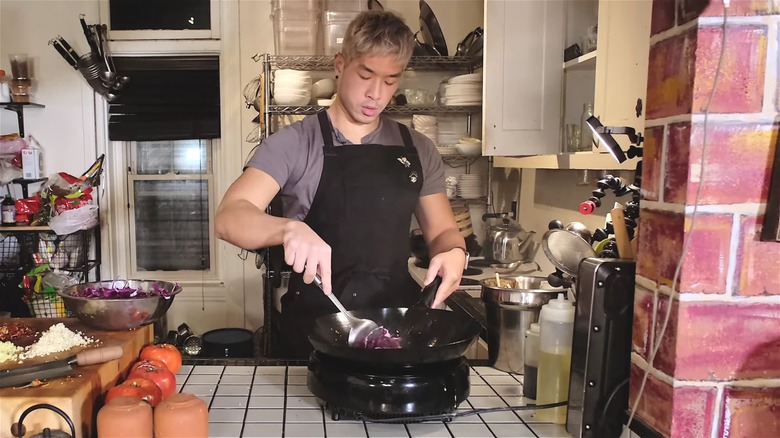
Jon Kung using induction hob
The absence of a naked flame leads many home cooks to believe that certain cooking techniques are not possible when using electric stovetops. Stir-frying is one such cooking technique. The perceived barriers to stir-frying on electric stove tops are threefold: The lack of a smoky flavor produced by live fire, which is known as wok hei, insufficient temperatures, and a lack of authenticity.
The first of these issues is easily solved; wok hei can be achieved by passing a blowtorch over the food during cooking. Concerns around temperatures are also easy to allay; electric burners have been found to produce temperatures over 100 degrees Fahrenheit hotter than gas burners. Opinions on the third point, authenticity, vary, although chef Jon Kung made a good point about induction hobs when he was interviewed by The Guardian: “You can buy a curved induction wok burner specifically made for woks […] That wok burner was literally made by Chinese people to cook Chinese food — when I cook in that it’s more of an authentic experience than cooking on a KitchenAid or a Viking range could ever be.”
Dishes that involve deliberately charring or burning ingredients, such as aubergines when making baba ganoush, are also perceived as being impossible to make with electric stovetops. However, ingredients like these can easily be charred by using a blowtorch or placing them directly under the oven’s broiler.
Ignoring The Hot Surface Indicators
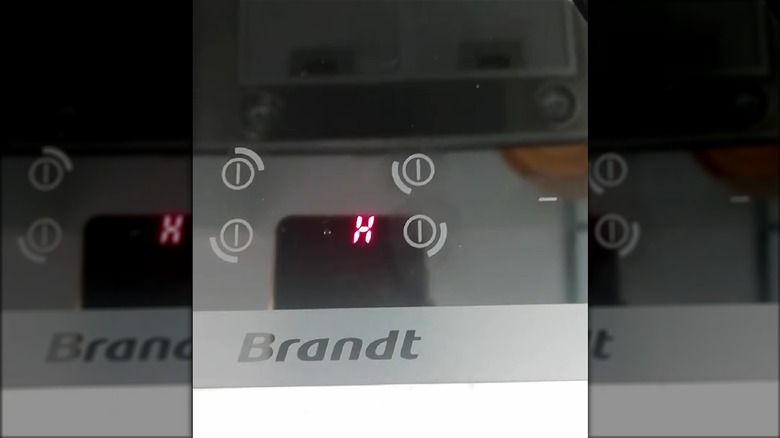
Hot surface indicator on hob
Many electric stove tops have hot surface indicators. Usually taking the form of the letter ‘H,’ these lights only come on after the stove top has been turned off. As the name suggests, these lights act as a means of reminding the cook that the stovetop is still hot. For many appliances, the warning light will remain on until the stove top’s temperature drops below 150 degrees Fahrenheit.
Hot surface indicators are important as many people take advantage of the electric hob glass top by using it as an extension of their worktop. Doing this while the burner remains hot can lead people to burn themselves or other items, warns Age UK. Subsequently, people are advised not to touch electric stove tops or use them as a worktops until the hot surface indicator has disappeared. 20 minutes is the usual time frame for this to occur.
The hot surface indicator also provides a reminder that food should be removed from this burner. Unlike gas stove tops, electric ones take much longer to cool down. If the hot surface indicator is ignored and food is left on the hot burner, it runs the risk of becoming overcooked or, in extreme circumstances, burnt.
Failing To Familiarize Yourself With The Temperature Settings
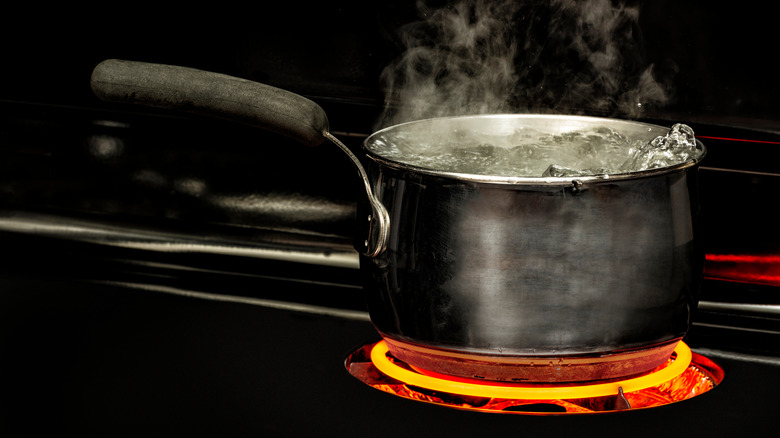
Water boiling on electric stove
There is no universal temperature setting structure for electric stovetops. Many appliances offer a scale of one to nine. Some have more options, others fewer. This means that each appliance has its own unique quirks that cooks must get used to. For example, setting number three might translate to medium temperatures on some electric stovetops. For others, it might result in mid-to-low temperatures.
Gas stove tops offer visual indicators of temperature; by studying flame size, cooks can easily work on an unfamiliar appliance. Electric stove tops — including induction burners — offer no such clues. Studying an appliance’s manual will provide a cook with some information on temperature settings, but actually cooking on the electric stove top is the only way to fully understand the appliance’s specifics. For this reason, cooks who are new to their electric stove top are encouraged to cook a range of foods, use different styles of cookware and experiment with a variety of temperature settings until they have a thorough understanding of the appliance.
Using The Incorrect Cookware
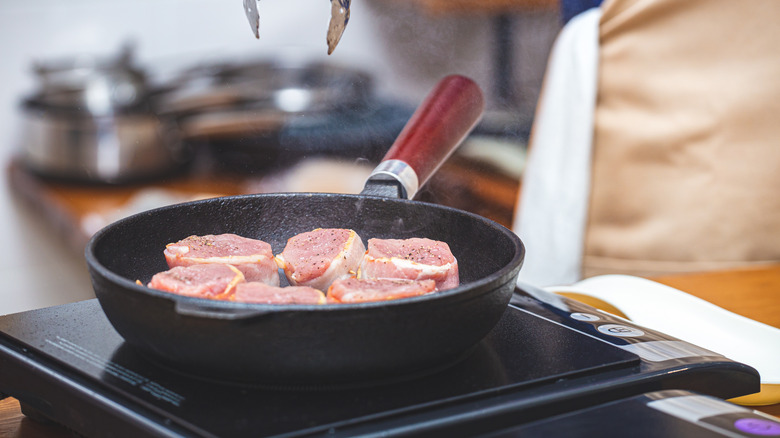
Cast iron skillet on hob
Not all cookware is suitable for use with electric stove tops, and using the incorrect type can have dramatic consequences. The types of cookware that should be avoided are pottery and stoneware. These materials do not react well to sudden temperature changes and can crack if they are placed directly upon an electric stove top. Cookware made from other materials, including cast iron, stainless steel, and copper, can all be used although the unique properties of each material will affect heat conduction and the subsequent cooking process.
The same can be said for the thickness of cookware. While thin cookware will be more responsive to temperature changes, it does not retain heat well and should not be used for processes that demand high temperatures, such as searing.
When it comes to cookware for use on electric stove tops, flat bottoms are essential. This is because flat-bottomed pans result in a much more efficient transfer of energy from burner to pan. Smarter House reported that warped or unevenly bottomed pans require 50% more energy than flat-bottomed pans to record the same result. This is a huge amount of energy to waste every time you cook.
Assuming They Are Much Safer Than Gas Stove Tops
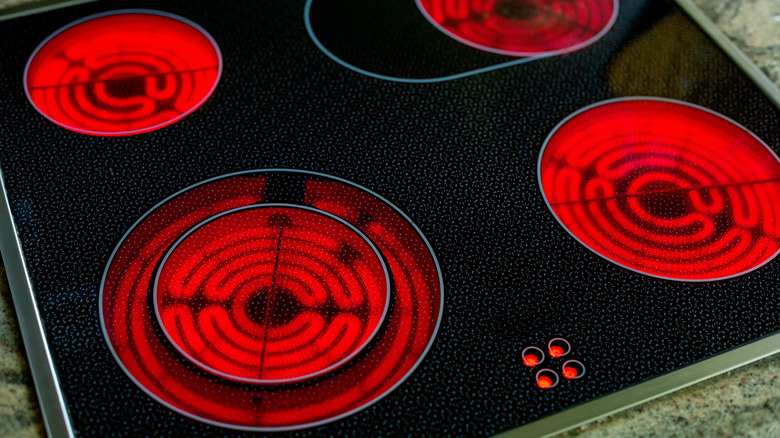
All burners glowing on stove
The lack of a naked flame leads many people to assume that electric stove tops are safer than those fuelled by gas. According to The National Fire Protection Association, the opposite is actually true. In the organization’s 2023 home cooking fire report, NFPA found that 64% of American households cooked with electricity stoves between 2017 and 2021. During this same period, 80% of home cooking fires resulted from electric ranges or cooktops.
The reasons for the increased prevalence of fires in homes where electric stove tops are used are many, including the fact that electric burners are more likely to be erroneously left on than gas burners. What’s more, as electric stove tops take longer to cool than those fuelled by gas, they remain a fire risk for longer.
Electric stove tops are also easy for children to turn on; all it takes is the touching of a button. To minimize the risk, cooks should always lock their electric stove top — using the specialist feature — when not directly monitoring it. Warnings provided by hot surface indicators should also be heeded.
Using The Highest Temperature For Anything Other Than Boiling
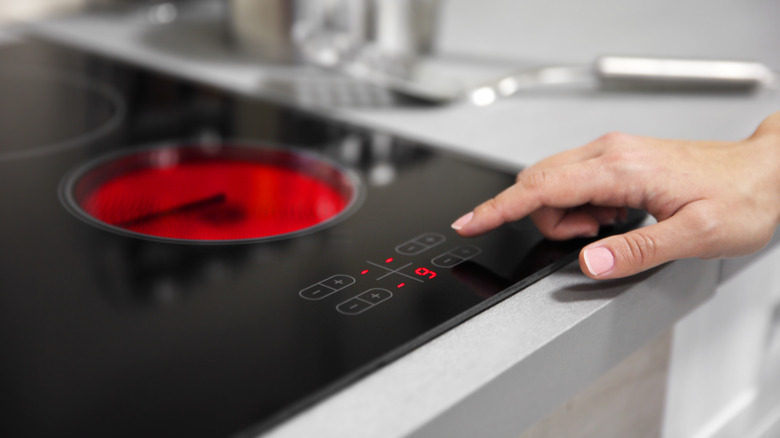
Electric hob on high setting
No matter how the electric stove top’s temperature settings are formatted, the highest setting should only be used to boil liquids. This is because the uppermost setting can result in the stove top reaching extremely high temperatures, anywhere between 500 and 750 degrees Fahrenheit. Using such high temperatures when cooking will almost certainly result in the food becoming burnt. Furthermore, the nature of electric stove tops means the burner will likely remain too hot to use for some time after it has been turned down.
The use of the highest temperature setting also risks damaging cookware, predominantly by warping it. As we have seen, warped pans result in a less efficient transfer of energy between burner and pan. What’s more, temperatures exceeding 500 degrees Fahrenheit can also damage the non-stick coating present on some cookware. As a result, the highest temperature setting is something all electric stove top users should rarely use.
Read the original article on Daily Meal.
News Related-
Russian court extends detention of Wall Street Journal reporter Gershkovich until end of January
-
Russian court extends detention of Wall Street Journal reporter Evan Gershkovich, arrested on espionage charges
-
Israel's economy recovered from previous wars with Hamas, but this one might go longer, hit harder
-
Stock market today: Asian shares mixed ahead of US consumer confidence and price data
-
EXCLUSIVE: ‘Sister Wives' star Christine Brown says her kids' happy marriages inspired her leave Kody Brown
-
NBA fans roast Clippers for losing to Nuggets without Jokic, Murray, Gordon
-
Panthers-Senators brawl ends in 10-minute penalty for all players on ice
-
CNBC Daily Open: Is record Black Friday sales spike a false dawn?
-
Freed Israeli hostage describes deteriorating conditions while being held by Hamas
-
High stakes and glitz mark the vote in Paris for the 2030 World Expo host
-
Biden’s unworkable nursing rule will harm seniors
-
Jalen Hurts: We did what we needed to do when it mattered the most
-
LeBron James takes NBA all-time minutes lead in career-worst loss
-
Vikings' Kevin O'Connell to evaluate Josh Dobbs, path forward at QB
